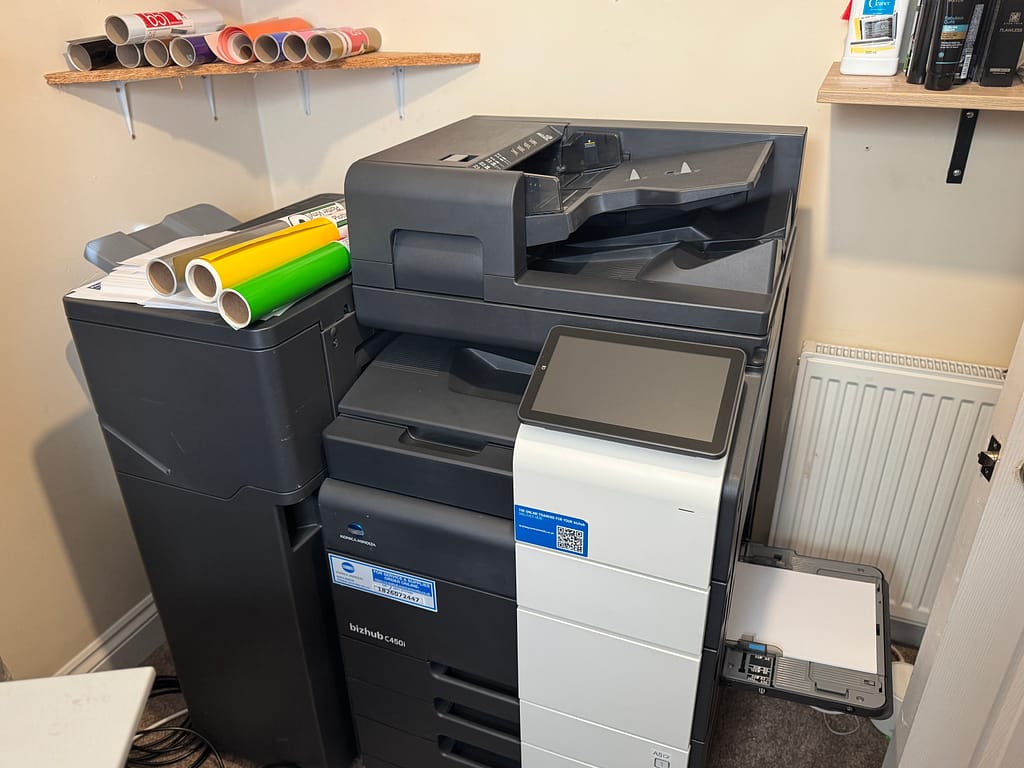By Mark Pammesberger/BROOLED LTD— three years owning all three machines, running a compact business-card printing setup alongside a Minolta Bizhub C450i with binder, puncher and folding add-on.
Meta description: A practical, experience-led guide to using the Magnum MCC35 cutter and two Rhin-O-Tuff punch/bind machines (HD8370 & HD7700) for a small business-card printing shop. Troubleshooting, workflow, and practical tips after three years of ownership — with real photos of the setup.



Introduction — why I bought these machines
Three years ago I started a compact printing setup with the specific goal of producing high-quality business cards in-house. Space is tight and budget matters, so I chose equipment that fits my studio and my ambitions: a Minolta Bizhub C450i (with binder, puncher and folding add-on) as the production printer, and three finishing machines — the Magnum MCC35 cutter, and two Rhin-O-Tuff units, the HD8370 and HD7700.
Compact print station: Minolta Bizhub C450i with Magnum MCC35 and two Rhin-O-Tuff finishers.
The idea was simple: print on the Bizhub, cut/trim with the Magnum, and use the Rhin-O-Tuff for heavy-duty punch and bind jobs when needed. In practice, I learned that some machines are easier to integrate into a one-person workflow than others, that small missing parts can ground a machine for months, and that the right workflow saves hours. This post walks through what I’ve learned in three years.
Quick summary of the three machines
- Magnum MCC35 cutter — a compact manual/semiautomatic cutter. Sturdy and space-saving, but not very intuitive for computer-driven automated workflows.
- Rhin-O-Tuff HD8370 — a heavy-duty punching & binding machine. Mine arrived missing a handle, which I’ve now ordered from a UK dealer.
- Rhin-O-Tuff HD7700 — a smaller, simpler punching machine for light-duty punch jobs and prototypes.
The Magnum MCC35 — my ongoing struggle (and a pragmatic workflow)
Why I chose the MCC35
Space constraints drove the choice. The cutters I originally wanted were too large and expensive. The Magnum MCC35 promised compactness and reliability.
Setting the backstop and blade depth on the Magnum MCC35.
What I like
- Small footprint and robust construction.
- Performs clean cuts once setup is correct.
What I don’t like
- Not computer programmable.
- Steep learning curve for repeat accuracy.
- Minimal documentation.
- Really hard to use
Practical tips
- Create labelled templates for each card size.
- Use registration marks.
- Print test strips.
- Calibrate backstop and blade height.
- Batch similar jobs.
- Sharpen blades regularly.
- Document every step.
Registration marks guide precise trimming for business cards
The Rhin-O-Tuff HD8370 & HD7700 — punching & binding made simple
The missing handle story (HD8370)
When the HD8370 arrived, it was missing a handle. Without it, I couldn’t apply the leverage needed for thicker stock. I’ve now ordered the part from a UK dealer.
HD8370 before and after the replacement handle — small parts matter!
Why I like Rhin-O-Tuff machines
- Strong and reliable punch.
- Simple maintenance.
- Intuitive use.
Punching test sheets on the Rhin-O-Tuff HD7700.
Integrating everything with the Minolta Bizhub C450i
Your print engine matters. The Minolta Bizhub C450i provides excellent print quality and integrates well with the bind and fold add-ons.

Printing the business card sheets on the Minolta Bizhub C450i before trimming.
Workflow:
- Design → PDF with crop marks.
- Print → check colour profile.
- Cut → align using registration marks.
- Punch/Bind → specialty finishing.
Print → Trim → Punch — the three-step finishing workflow.
Troubleshooting
| Problem | Fix |
|---|---|
| Inconsistent cuts (MCC35) | Sharpen blade, check backstop, use registration marks |
| Thick stock won’t punch (HD7700) | Reduce stack, use HD8370, check dies |
| Colour shifts | Calibrate Bizhub, test profiles |
| Missing parts | Order replacements immediately |
Design & production tips
- 3 mm bleed and safe zone.
- CMYK colour.
- 350–400 gsm stock.
- Rounded corners if cutter allows.
Final thoughts
After three years, I’m confident handling small-to-medium card jobs. The Rhin-O-Tuff units will soon be fully operational, and while the MCC35 isn’t my dream cutter, it gets the job done with care and consistency.
If you’re starting a compact business-card setup, choose:
✅ Reliable printer
✅ Practical cutter
✅ Solid punch/binder
✅ A methodical workflowFinished 350gsm business cards ready to ship.
If you like to read more then I recommend About us page or the About Me where you find out more about me and what I do. There is also the Equipment page where I introduce the products and equipment I use Equipment I use.
If you like what you read please subscribe to my blog, share it with your friends and comment on the post. I like to hear from you!